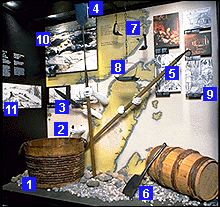Canada Hall
 A Whaling Station
A Whaling Station
Whaling
Whales were hunted in small lightweight rowboats called chalupas. Wooden floats attached to the harpoon line acted as a drag to exhaust them and prevent them from diving below the surface. The whales were killed with a louchet, or killing lance, which was driven into the heart, located behind the pectoral fin. Because they were struck repeatedly, there was a severe loss of blood.
Basque whalers recited this prayer at the moment of harpooning:
-
... Allow us, Mighty Lord, to quickly kill the great fish of
sea; without injuring any one of us when he is bound by the line
in his tail or his breast; without tossing the boat's keel skyward,
or pulling us with him to the depths of the sea... The profit is
great, the peril is also great; guard above all our lives.
 |
|
Why whaling? The whale hunt supplied Europe with much needed products for industrial and personal use. Europeans used millions of gallons of whale oil for lamp fuel and lubrication. Whale oil was a basic element of paint, varnish and soap. Baleen -- a flexible, strong material from whales' mouths -- was used in clothing and furnishings. To supply these markets, the Basques killed thousands of whales.
 |
|
A typical whaling ship carried 1,250 barrels containing the oil of about twenty-five whales. These barricas were floated out to the ship and loaded into the hold. Barrel-making was an essential activity of every whaling expedition. Coopers assembled the barrels for shipping oil and also made or repaired other containers. Those activities made them key members of a whaling crew. Ships' stores included previously used barrel staves and head pieces as well as split willow and alder for making the hoops.
 |
|
